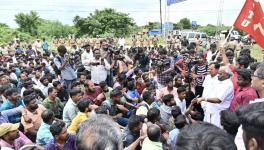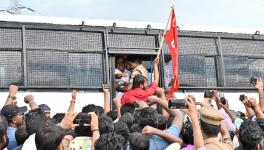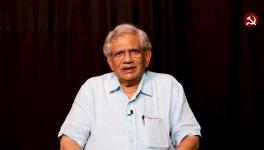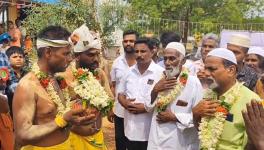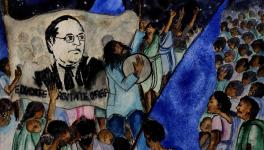Jallikattu – A Movement Facing Backwards
This is the first part of a two-part note on the crisis of the Dravidian movement and its ideology and its manifestation in the contemporary social and political life of Tamil Nadu. We consider two events that have rocked the state recently – the jallikattu protests and the illness and demise of Jayalalitha followed by the rise of Sasikala. Both these events together we argue expose the obscurantist and backward-looking aspects of the Dravidian movement and its ideology, its inability to understand or build in progressive fashion on the material aspects of the development of Tamil society and its inability to provide a way forward to Tamil society at the present time.
The eruption of protest against the Supreme Court ban on jallikattu, certainly caught most people by surprise. For more than a week, large crowds, self-regulated it appeared (though that remains to be verified in greater detail, especially the absence of organisers of established political formations), gathered in many places in Tamil Nadu, vowing not to disperse until their demands were met.
It is also evident that the protests had the tacit blessing of large sections of the political establishment, especially the ruling AIADMK, even if it initially caught them unawares. All of the parties of the Dravidian movement's establishement, as well as its various offshoots, have a valued support base (to varying degrees) among the middle-caste rural rich, especially in southern Tamil Nadu, who provide the main social basis of the jallikattu phenomenon. All political parties in Tamil Nadu, virtually without exception, have opposed the jallikattu ban over the years. The protests therefore were all about timing and immediate action without any real political opposition being involved.
Without this background of political support, tacit or otherwise, it is not credible that the police in Tamil Nadu, who have a track record of dealing heavy handedly with large-scale public defiance of law and order and are known to be quick on the draw in curbing the right to protest, should permit these protests under their benevolent gaze without nipping them in the bud. How else can we explain the spectacle of a train, brought to a halt over the Vaigai river bridge at Madurai, that was not moved out for three full days, or for that matter, large gatherings in every part of the state in a number of major towns that disrupted daily life, including road blocks that halted bus transport?
Our reading is amply justified by the expeditious clearing of the protestors across the State in less than a day, once the government decided to act. Having utilised the protests to blunt any hesitation on the part of the Centre in supporting the proposed ordinance restoring jallikattu, not that the Centre was inclined overmuch to object, and once the ordinance was passed, life was returned to normalcy with customary despatch. The “efficient” manner in which this was done, with the police, reverting to form once called into action, brutally lathi-charging protestors in parts of the state, belied the seemingly hapless state of the O. Paneerselvam government when the protests began.
Despite the popular mobilisation evident in the protests, the essential content of the protests could hardly be regarded as progressive. The protestors had no time for the reasoning that had animated the Supreme Court's judgements over the years on jallikattu. The simple fact that jallikattu, from the point of view of public safety, deserved to be banned, for the repeated occurence of serious injuries on a wide scale and even associated fatalities were brushed aside by the protestors. Indeed, immediately after the passage of the ordinance, when jalllikattus were held, it resulted in 7 deaths and more than 50 cases of severe injury. Nor were the protestors prepared to accept the evidence, provided in detail, that the bulls used in the jallikattu were routinely ill-treated in a number of unacceptable ways.
The protestors, or their more articulate spokespersons, that included virtually every single celebrity (notably but not only from the world of Tamil cinema) and the majority of the leading figures in the “Tamil” public sphere (if one may call it that), brushed aside all such rational arguments. Wilder elements among the protestors called for the banning of PETA India (the People for the Ethical Treatment of Animals). But the common thread among all protestors was the notion that jallikattu was some “intrinsic” part of Tamil culture, that the “culture” rationale rendered invalid any rational examination of the whether jallikattu should be permitted or not, and that the rule of law in these matters, even if it was pronounced on by the Supreme Court, was trumped by “popular” opinion.
If one substitutes the word jallikattu by the words “Ram temple” and the word “Tamil culture” by “Hindu culture” in these arguments, many would have no hesitation in naming the protest as a reactionary one. However, it is a remarkable fact that the intrinsic irrationality and obscurantism that is part of essentialist appeals to a “Tamil” culture or “Tamil pride” escapes such oppobrium. We shall return to this point again.
That the jallikattu is definitely an irreligious event, even if held on the occassion of Pongal, in any case itself a harvest festival, does not take away from the obscurantism inherent in the view that the reasons for desiring it to be held are not to be subject to rational enquiry. Even if irreligious in nature, jallikattu has other retrogressive social features associated with it. For long it has been associated with the celebration of the event by particular castes, with Dalits in particular not being allowed to even touch the bulls readied for the event. Dalits could hold their own jallikattu events, but they had to be separate. The extent of operation of caste taboos and discrimination in the present, implicitly or otherwise, merits further study, but it has certainly been active in the recent past and is unlikely to have entirely and fully receded.
Other diversionary arguments in support of jallikattu are quickly exposed. The notion that the jallikattu promotes the breeding of high-quality specimens of indigenous breeds is patently ridiculous in a state where an eminently successful milk co-operative program has developed over the last forty years based on modern techniques of breeding of livestock. Another diversionary argument inserted in the debate was based on the recycling of some pseudo-scientific arguments on the quality of milk of indigenous breeds as opposed to milk from breeds which had been the product of crossing with foreign breeds. If anything these arguments illustrate the global phenomenon that pseudo-environmentalism is often the last refuge of revivalism, in relation to romanticist ideologies that have long been in decline.
One may argue that to be consistent with genuine concern for animals one must also support vegetarianism (as indeed PETA India appears to do). And since imposing vegetarianism is not acceptable, ipso so is a ban on jallikattu. This too obviously is a specious argument, since quite apart from what PETA or others think, the consumption of meat or animal products need not be in conflict with ethical treatment of animals from a number of philosophical or ethical viewpoints. And in any case the Supreme Court judgement covered solely the issue of jallikattu and did not extend to other questions.
On the political plane, some, especially on the Left, have been inclined to see an anti-BJP stance or an anti-Central government stance behind these protests, arguing that the protests represented something much more than unhappiness on the jallikattu issue alone. It is a strange argument that an irrational demand can be justified on the basis that there lurk more valid reasons in the background. It may of course be that such genuine reasons may trigger an expression of anger, but one cannot escape thereby the duty to stand against a reactionary, irrational or obscurantist expression of this anger. By this token every expression of anger, against immigrants for instancee, may be equally justified. In any case it is not very credible that the movement expressed, apart perhaps from stray outbursts, anything more than the desire to see jallikattu restored.

Image Courtesy: commons.wikimedia.org
At the end of the day we are led inescapably to the conclusion that the mass protest was, to adapt Meera Nanda's evocative phrase, a “movement facing backward”. The contrast between the social background of the protestors and the cause they mobilised for, especially in the urban segment, could not have been more striking. It is likely that the vast majority of the urban participants had not even seen a single jallikattu event in their lives. Jallikattu events are not certainly not women-friendly ones, nor are we about to witness the take-off of a movement for jallikattu by women, despite the significant participation of women in the protests. Media reports writing of the participation of IT professionals in the protests, enabling the use of digital technology for communicating among the protestors, highlighted even more starkly the contrast between the instrumental aspect of access to modern technology, vis-a-vis the backward state of rational thinking, or if you will scientific temper, in the public sphere.
The strikingly obvious point to be made here is the demonstration of the considerable hold of the ideology of the Dravidian movement in the socio-cultural life of Tamil Nadu, at a time when the material realities of Tamil society have moved far ahead from the era when this ideology was fashioned. Equally striking is the absence of any such mobilisation against the backward or crisis-ridden aspects of Tamil society, which the Dravidian movement, its ideology and the political parties that draw from it, have failed conspicuously to deal with. Foremost among these in the social realm, is the widespread regression to caste oppression and discrimination, across the state, manifest most starkly, though not solely, in the brutal murders of Dalit youth involved in inter-caste marriages and the public campaigns against such relationships. In the realm of political economy is the crisis of Tamil Nadu's agriculture – the faux concern for rural society in Tamil Nadu (where some presumed essential aspect of “Tamil” culture is located in the form of jallikattu) could not be more farcical in light of the contemporary crisis of Tamil Nadu's agrarian economy. It is a mark of the crisis of Tamil society that one of the most successful mass mobilisations in recent times, albeit of short duration, predominantly youthful in character, should be on the basis of a return to an “imagined” roots, whose material basis has long been superseded in substantial ways.
The ideology of the Dravidian movement, it must be recalled, has long taken a path aligned increasingly to a fundamentally obscurantist and irrational view of Tamil society and history. While this ideology initially had a basis in a partially progressive anti-Brahmin movement with a strong rationalist and modernist drive, and the urge to assert the role of a regional elite in the face of the unitary view of nationalism of the Congress in the immediate post-independence era, these progressive inclinations have long been set aside. Anti-Brahminism in Tamil Nadu has never confronted the issue of Dalit discrimination and oppression, the worst forms of which have returned in the Tamil Nadu countryside and spillover into urban life. The rationalism and modernism of Periyar has long been set aside in the propagation of a idea of a Tamil society, based on mythical notions of the antiquity of the language, fanciful notions of the historical origins of the language and society, a literal interpretation of classical texts in the understanding of Tamil society in history and so on. In particular, rationalism and a scientific temper have been set aside in favour of a portrayal of an ostensibly syncretic view of a particularly Tamil religiosity, partly promoted as literature -- that is frequently no more than propagation of religious ideology. The school and college classroom, it bears mention, have been the active site of the propagation of such views over a long period. Tamil cinema, has also played a significant role in this regard, a role so well-known, that it does not call for much comment.
Alongside this, a good deal of the “invention of tradition” (to use Hobsbawm's elegant characterisation) has also clearly taken place during the rise of the Dravidian movement and the consolidation of its hold on Tamil society. The contemporary jallikattu , at least in part, owes something to this phenomenon. Another undercurrent, or sub-text, to jallikattu is the celebration of male “valour”, a classic theme in Tamil literature, but which also runs through the invocation of “Tamil pride”, the counter-point to which is female “chastity” (or karpu, in Tamil). It is not obvious whether this theme was articulated in the protests, more unlikely than not. But clearly to the many revivalist commentators, who saw in the movement an opportunity to refurbish the credentials of an ideology in danger of decline, this must have been evident.
For democratic, progressive thought in Tamil Nadu, the jallikattu protests should not be an event for celebration, but a window to a crisis of thought that must be cause for profound concern. One urgently needs to call out the obscurantism that has come to dominate contemporary Dravidian ideology, alongside the obscurantism of Hindutva. In so far as Tamil society is concerned, this brand of obscurantism is equally a danger. Or to put it differently, in the broad sweep of an attempt to promote obscurantism in contemporary Indian life, contemporary Dravidian ideology is its particular manifestation in Tamil Nadu. And just as we need to go beyond Nehruvian secularism and scientific temper in the opposition to Hindutva, so too we must recognize the stark limitations of the progressive, rational elements such as the thought of Periyar and his impact on the life of Tamil society. The superficial anti-North rhetoric of the Dravidian movement, should not blind us into considering it as a credible force against the other, more widespread currents of obscurantism in India as a whole.
But these considerations are not a recipe for gloom. For on the other hand, while the jallikattu protests demonstrate the hold of the ideology of the Dravidian movement, the objective conditions that provide for weakening this ideological hold are also present, especially in the evolution of Tamil Nadu's political life. We will turn to this other aspect of the contradiction in a subsequent piece on the contemporary political crisis in Tamil Nadu and the opportunities that it affords.
Disclaimer: The views expressed here are the author's personal views, and do not necessarily represent the views of Newsclick
Get the latest reports & analysis with people's perspective on Protests, movements & deep analytical videos, discussions of the current affairs in your Telegram app. Subscribe to NewsClick's Telegram channel & get Real-Time updates on stories, as they get published on our website.











